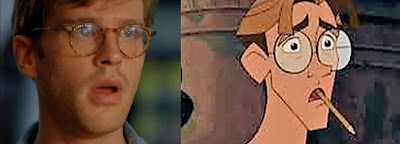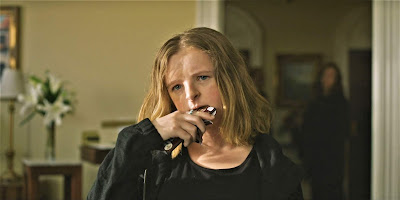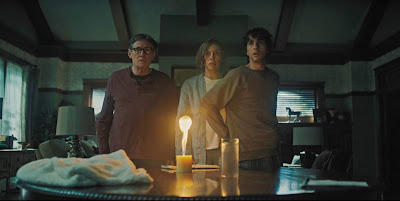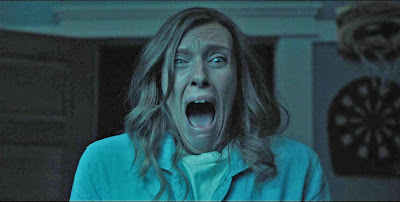The Crush is Trash Cinema in its purest, most uproariously unregenerate form. For try as I might to ascribe seriousness of intent to this overheated opus involving a neglected teen’s serial attachment to surrogate father figures; accredit forethought to the extended Frankenstein metaphor wherein accelerated physical and intellectual development fatally presumes a corresponding emotional maturity; or even shoehorn in an indictment of our culture’s tolerance for the sexualizing of adolescent girls…it’s all for naught. The Crush is never more than what it aspires to be in the moment, and utterly what it appears to be on the surface: a 100% empty-calorie, all-cheese buffet with nary an ounce of socially redeeming value to be found in its economic (nay, rushed) 89-minute running time.
In lieu of explicitness, The Crush instead opts for a kind of moral schizophrenia that's committed to playing both sides of the film's Penthouse Forum scenario. On the one hand, the film aggressively sexualizes the character played by 16-year-old Alicia Silverstone and invites the viewer to share its leering, ogling gaze. On the other, the film tries to convince us that it also condemns the hypersexualization of young girls and their bodies. The latter, none too persuasively.
The feature film debut of Disney Channel (wouldn't you know it?) director Alan Shapiro, The Crush--which has the feel of one of those straight-to-video erotic thrillers with Shannon Tweed or Richard Grieco--was filmed in Vancouver, B.C. on a budget of $6 million and a paucity of marquee names in the cast. But its timing was good. Rising star Alicia Silverstone was making her film debut, and arrived star Cary Elwes, who was somewhat hot at the time having appeared to favorable effect in The Princess Bride (1987), Hot Shots! (1991) and Mel Brooks' Robin Hood: Men in Tights (1993)...but it's hard to know if The Crush represented an ascension or a downturn in his career trajectory.
The feature film debut of Disney Channel (wouldn't you know it?) director Alan Shapiro, The Crush--which has the feel of one of those straight-to-video erotic thrillers with Shannon Tweed or Richard Grieco--was filmed in Vancouver, B.C. on a budget of $6 million and a paucity of marquee names in the cast. But its timing was good. Rising star Alicia Silverstone was making her film debut, and arrived star Cary Elwes, who was somewhat hot at the time having appeared to favorable effect in The Princess Bride (1987), Hot Shots! (1991) and Mel Brooks' Robin Hood: Men in Tights (1993)...but it's hard to know if The Crush represented an ascension or a downturn in his career trajectory.
What the film lacked in bankable names it made up for in topicality: The Crush came out at the peak of the public’s feeding frenzy fascination with the sordid Joey Buttafuoco /Amy Fisher “Long Island Lolita” sleaze-fest dominating the tabloid headlines in 1992. The scandal spawned three TV movies, but The Crush was the only feature film and work of (semi) fiction to capitalize on the public's apparently insatiable interest in teen seductresses.
 |
| Cary Elwes as Nicholas Eliot |
 |
| Alicia Silverstone as Adrian/Darian Forrester |
 |
| Jennifer Rubin as Amy Maddik |
Having landed a plum writing gig at trendy Pique Magazine, hotshot investigative journalist Nick Eliot (UK-born Cary Elwes, ever on the losing end of a battle with an American accent) packs everything he owns into the back of his vintage Plymouth Valiant convertible and moves to Vancouver, Wahington...which I think is standing in for Seattle). Anyhow, in short order he rents a picturesque above-garage apartment in a tony suburban neighborhood from a busy professional couple with a precocious 14-year-old daughter named Adrian (Silverstone)...or Darian if you’re a lip-reader...who almost immediately develops a crush on the new tenant. Adrian's adolescent flirtation starts out innocently -if invasively- enough with the besotted teen gifting Nick a set of clip-on sunglasses (sweet). Then it moves on to her surreptitiously rewriting one of his magazine articles for the better (out of line). It comes to a head when she gets him to drive her to a secluded spot where she can pour out her heart to him about how tough it is to be a pulchritudinous, 14-year-old virgin who's also a genius, a piano prodigy, a seasoned equestrian, and an expert in entomology (creepy).
For his part, Nick goes from flattered, to annoyed, to empathetic...ultimately settling in somewhere around dumbfounded. The latter allowing for things with Adrian to go as far as finger-sucking (who among us hasn’t let an infatuated middle-adolescent tongue our cuticles?) followed by a wildly inappropriate kiss. Snapping to his senses, Nick is quick to establish firm, distinct boundaries for the teen…but only after circumstance and his own profound stupidity have him sneaking into Adrian’s house, catching a gawking glimpse of her discarded panties, and “accidentally” watching her fully undress from the vantage point of his hiding place inside her louvered door closet.
Now more convinced than ever that her feelings for Nick are fully reciprocated, Adrian the Equestrian comes to regard his eleventh-hour protestations and capitulations to propriety as little more than what they probably are: guilt-based, locking the barn door after the horse has bolted ploys (or zipping the fly after the…well, you get the idea). Alas, by the time Adrian’s feelings have grown so strong that she feels comfortable greeting the judgment-impaired writer with a cheery “Hello, Nicholas darling!” Nick has moved on past unintentional teen-teasing and has embarked on a more age-appropriate romance with an associate from work, photojournalist Amy Maddik.
 |
| "Nick, I've been there. You have to be the adult. You can't blur the line." |
Stinging from the potential threat of Nick’s new girlfriend (“Oh, don’t worry, Amy. Some guys really like girls with small breasts!”) and seething with resentment over Nick’s rebuff of her advances (“Too busy kissing ass to care about me, is that it?"), Adrian Forrester is left with no choice but to go full Alex Forrest (her homage namesake Glenn Close in Fatal Attraction) on the pair.
Consistently silly and flagrantly derivative (it’s Fatal Attraction by way of Lolita and The Bad Seed ) it perhaps goes without saying that I find The Crush to be also ceaselessly entertaining and irresistible as all get-out. Serving up sizable chunks of cheese, sleaze, and lurid camp, The Crush is absolutely fabulous without ever really being any good. It's a film that cries out for the MST3K treatment, and proves to be a film whose entertainment value increases exponentially in direct proportion to how many other people you see it with. It's a guaranteed good time so long as you take care not to allow certain things to intrude upon your viewing experience that might tend to spoil your fun…like your brain.
 |
| Adrian and her friend Cheyenne (Amber Benson) spy on Nick. Teenage crushes have really come a long way since The World of Henry Orient (1964) |
I didn’t get
around to actually seeing The Crush
until it was released on VHS cassette in 1995, by which time not only had word got around
that the film was a tawdry hoot, but Alicia Silverstone had gone on to become
the queen of MTV by way of a trio of heavy-rotation music videos she appeared
in for the band Aerosmith. The Crush wasn't very popular on initial release (it has since developed a cult following) but MTV's shameless hyping of Silverstone was instrumental in her landing two MTV Movie Awards (Best Villain and Best Breakthrough Performance) for a movie nobody saw. Things picked up for Silverstone when she was cast in Amy Heckerling’s Clueless (1995), and just as quickly went south for her when she appeared as Batgirl in the deservedly ill-fated Batman and Robin (1997).
I wasn't terribly surprised by how much I liked The Crush, for I'm one who never got over Mamie Van Doren’s retirement, mourned the demise of the Reform School Girl B-picture genre, and pine for the days when underground films by Andy Warhol and John Waters spoofed Hollywood trash. Happily, Silverstone's pouty pariah seems to be channeling Ann-Margret in Kitten With a Whip (1964) by way of Joey Heatherton in Where Love Has Gone (also 1964. It was apparently a very good year for bad girls). And while the menace of Silverstone's characterization never reaches the delirious heights of kung-fu Elizabeth Berkeley in Showgirls; by way of compensation, we get to marvel at the many ways she's been directed to perpetually tilt her head and peer over the top of her sunglasses.
In the VHS copy of The Crush I watched several years ago, Silverstone’s character was named Darian. That's because director/screenwriter Alan Shapiro based The Crush on an actual experience he had in 1982 when he was a struggling writer renting a guest-house from a family in Beverly Hills. When the family’s teenage daughter (actually named Darian) developed a crush on him, his snubbing of her attentions resulted in the retaliatory act of her carving an obscenity into the paint of his car (a scene recreated in the film). Shapiro left the house not long thereafter, but he used the incident as a springboard for his screenplay. Even going so far as to keep the girl’s name the same (understandable, given how it suggests Damien, the name of the Antichrist in The Omen).
But verisimilitude has its price. Especially when said teen is depicted as homicidal
and seriously off her nut. Sometime after the film's release, the parents of the real-life Darian hit Shapiro and Warner Bros. with a libel lawsuit, a resultant term of the out-of-court settlement being that the
character’s name had to be changed in all subsequent prints. Thus, in future VHS copies and once The Crush began showing up on TV,
Laserdisc, and DVD, Darian became Adrian, and all references to and appearances of
it in the film had to be dubbed over or digitally altered. I can’t imagine this
costly development went over well with the studio --"You mean to tell me you used the girl’s ACTUAL NAME?!"--which may explain
why Shapiro’s directing career came to a grinding halt after directing just one
other feature: Flipper (1996).
In the VHS copy of The Crush I watched several years ago, Silverstone’s character was named Darian. That's because director/screenwriter Alan Shapiro based The Crush on an actual experience he had in 1982 when he was a struggling writer renting a guest-house from a family in Beverly Hills. When the family’s teenage daughter (actually named Darian) developed a crush on him, his snubbing of her attentions resulted in the retaliatory act of her carving an obscenity into the paint of his car (a scene recreated in the film). Shapiro left the house not long thereafter, but he used the incident as a springboard for his screenplay. Even going so far as to keep the girl’s name the same (understandable, given how it suggests Damien, the name of the Antichrist in The Omen).
 |
| What's in a Name? This digital transformation of D.F. to A.F. is smoother than the sound dubbing. None of the original actors were brought back to rerecord their lines. |
Before I saw The Crush, the purposeful evocation of Stanley Kubrick’s Lolita (1962) in both its marketing campaign and the casting of Sue Lyon lookalike Alicia Silverstone had me wondering (fool that I am) if perhaps the thriller might be some kind of a subversive upending of the whole Lolita Myth (the sexually predatory child who looks and behaves older than their actual age). Maybe even a parable indictment of our culture’s endorsement of the sexual “adultification” of adolescent girls (à la Brooke Shields and Nastassja Kinski) and blaming them for enticing hapless, innocent men.
 |
| Alicia Silverstone was 15-years-old when cast in her debut film (16 when production began) Sue Lyon was 14-years-old when cast in her film debut (15 when production began) |
The truth is that The Crush is like the Reefer Madness of The Lolita Myth. Female and male are vixen and victim in a stacked-deck narrative that has the character of Adrian depicted as a child only when the film wants to play up the taboo, schoolgirl fetish angle of the story (her ultra-girly bedroom, overflowing with stuffed animals and floral patterns, looks like it belongs to a 10-year-old). In all other ways, the viewer is encouraged to see her as a woman.
Because we never see her interact with boys her own age (ostensibly because they find her intelligence off-putting) and because her attractiveness and healthy interest in boys/men are never contextualized, Adrian's budding sexuality is never framed in terms of adolescent normalcy.
 |
| Attractive Nuisance The Crush understands and exploits (but has no opinion about) the fetishizing of youth and how it feeds into the taboo allure of adolescent sexuality |
The non-logic of The Lolita Myth never faults the tempted...men...all blame falls to the object of desire, as though men's sexual feelings are something they cannot be expected to control. A young, attractive girl who dares recognize and own her sexuality is seen as a risk and a threat simply by her existence and proximity. Even without action on her part, a woman or girl's body is imbued with the power to bait, tease, lure, and tempt. Never mind that her sexualization is something fabricated exclusively in the mind of a man via his own gaze. The Crush ratchets up the absurdity of this misogynist conceit into a worst-case scenario fantasy in which assertive female sexuality is not only toxic, it's homicidal.
 |
| The photo of Nick's journalist grandfather is actually The Crush's cinematographer Bruce Surtees with his grandchild (judging by the different lighting, I'd guess with the head of Elwes as a child grafted over the little boy). The late Oscar-nominated Bruce Surtees (Lenny - 1974) also shot the films Night Moves, Play Misty For Me, and Sparkle |
While the film plays fast and loose with making Silverstone look girlish or womanly depending on what message they're trying to send to males in the audience (alternating between "You lucky dog!" and "Better stay away from that young stuff, they're nothing but trouble!"), its treatment of Cary Elwes is pretty consistent: he's a dope who gets duped.
Though Nick has the professional reputation of being a bulldog investigative reporter (suggesting shrewd intelligence and a certain assertiveness), Adrian is the one with all the guile and cunning. Outfitted with goofy spectacles and dressed in oversized clothes that make him look like a little boy who's raided his father's closet, Nick may sneak peeks at Adrian sunbathing, or need to take a shot of vodka to clear his head after getting all hot and sweaty after a don't-stand-so-close-to-me encounter with a girl half his age; but in the lunatic confines of this thriller, he's the one seen as Little Red Riding Hood, she's The Big Bad Wolf.
 |
| In a nod to Hitchcock's Strangers on a Train (1951), a merry-go-round figures into the climax of The Crush |
Were The Crush a better-made movie, I think I’d
have found its alarmist view of female
sexuality obnoxious. There's a real story hidden here somewhere, about how girls who scare boys of their own age by being smart, attractive, and self-possessed, can feel abandoned (or drawn) to the inappropriate attentions of older men. But the female-phobic, male-centric focus of The Crush dooms the story to a social cluelessness it never overcomes.
The Crush reminds me of the time when I was a kid and my baby sister sought to extend the play life of her older, balding, Barbie doll by removing its head and replacing it with a newer one. It's hard to be offended by The Crush because it isn’t really about anything; it’s just Fatal Attraction with a younger head attached.
The Crush reminds me of the time when I was a kid and my baby sister sought to extend the play life of her older, balding, Barbie doll by removing its head and replacing it with a newer one. It's hard to be offended by The Crush because it isn’t really about anything; it’s just Fatal Attraction with a younger head attached.
 |
| Possession Obsession An homage to Fatal Attraction's iconic "lamp switch" scene. Complete with stuffed bunny rabbit |
Clip from "The Crush" (1993)
If you're a fan of thrillers and are in the market for a movie that head-on confronts all the subtextual creepiness The Crush sidesteps, I'd recommend Hard Candy (2005) starring Elliot Page and Patrick Wilson. Not for the faint of heart, but a real jolt of a suspense thriller.
Copyright © Ken Anderson 2009 -2019





























































